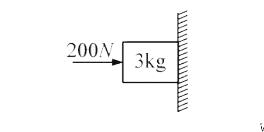
Consider the situation as shown in the figure. A constant horizontal force 45 N acting on the lower blocks produces an acceleration 4(m)/(s2), the two blocks always move together. Find (a) coefficient of friction between the bigger block and the horizontal surface (b) friction acting on the upper block and (c ) work done by the friction on the upper block during a displacement 2m of the system.

(a) N0=50N,f=μN0=50μ,F=45N
For system of blocks,
F−f=(2+3)a
45−50μ=5a=5×4
μ=12
(b) Upper blocks 2kg→a=4ms2
f′=2a=2×4=8N
(c ) W=f′d=8×2=16J
Topper's Solved these Questions
Similar Questions
A block of mass m is kept over another block of mass M nd the system rests on a horizontal force F acting on the lower block produces an accelertion F2(m+M) in the system the two blocks always move together. A. Find the coefficient of kinetic frictioin between the bigger block and th horizontal surface. b. find the frictional force acting on the smaller block. c. Find the work done by the force of friction on the smaller block by the bigger block during a displacement d of the system.

View SolutionA block of mass m is kept over another block of mass M and the system rests on a horizontal surface. A constant horizontal force F acting on the lower block produces an acceleration F2(m+M) in the sytem. The two blocks always move together. Consider displacement d of the system.
a. Find the work done by friction on bigger block.
b. Find the coefficient of kinetic friction between the bigger block and the horizontal surface.
c. Find the frictional acting on the smaller block.
d. Find the work done by the force of friction on the smaller block by the bigger block.
e. Find the work done by static friction on bigger block.

View Solution
Knowledge Check
Consider the situation as shown in figure, frictional force acting between surface and 3 kg block is
 A15 NB10 NC0 ND4 N
A15 NB10 NC0 ND4 NIf coefficient of friction between both the block is μ−12 . Find friction force acting between both block.
 A16NB20NC8ND10N
A16NB20NC8ND10NIn the arrangement shown in figure, coefficient of friction between the two blocks is μ=1/2. The force of friction acting between
 A8NB10NC6ND4N
A8NB10NC6ND4N
Find the force of friction acting between both the blocks shown in the figure.
View SolutionA block of mass 5 kg is pulled along a horizontal. The friction coefficient between the block and the surface is 0.5. If the block travels at constant velocity, find the work done by this applied force during a displacement 4 m of the block.
View SolutionA force of 200N is applied as shown in the figure on block of 3 kg. The coefficient of friction between the block and the wall is 0.3. Find the friction acting on the block. (in N) {Take g = 10 m/s2

View SolutionA force of 10N is acting on a block of 20kg on horizontal surface with coefficient of friction μ=0.2. Calculate the work done by the force.
View SolutionConsider the situation as shown in the diagram.
The coefficient of friction between the block is 0.5. The acceleration of the lower block is
View Solution
